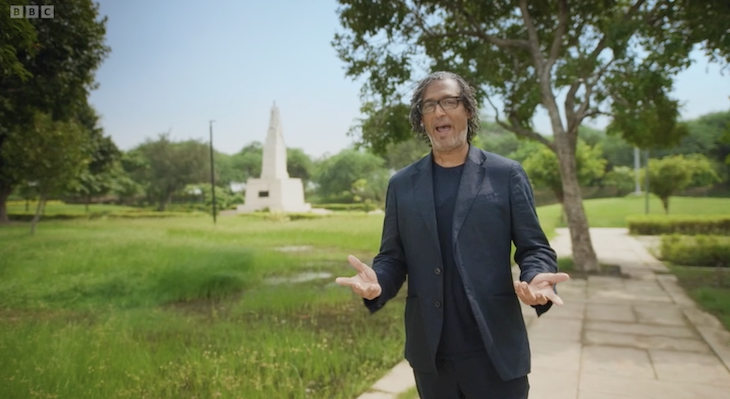
Among the most striking and memorable exhibits in the British Museum are the Assyrian reliefs depicting the royal hunt. These huge panels show the king, Ashurbanipal, shooting, spearing and stabbing a succession of lions, albeit ones that had been trapped beforehand and released from cages for the occasion. It is a magnificent work of art, carved in the city of Nineveh – on the outskirts of modern-day Mosul in northern Iraq – around the middle of the 7th century BC.
My favourite section shows the king on horseback, riding full pelt, with no reins in his hands but only his bow and arrow. Our eyes are drawn to the detail of Ashurbanipal’s robe, the ringlets of his beard and hair, the expressions of horse and rider: the horse is champing urgently forward; the king, the very image of regal composure, stillness in motion, is calmly aiming his arrow, holding it in place with his thumb while stretching the bowstring with a delicately bent index finger. But Selena Wisnom would have us notice something else. Tucked into the king’s belt is a stylus. A telling detail. Here is a man who wants his literacy to be noticed. In any situation – in battle, in hunting – the king is ready to write.
For Ashurbanipal, literacy as much as might was a source of pride. Not just basic literacy, in fact, but prowess. In one inscription, on a clay tablet also in the British Museum, he boasts of being the equal of any of his scholars:
I have learned the craft of the sage Adapa, the secret hidden lore of all the scribal arts. I have read cunningly written texts in obscure Sumerian and Akkadian that are difficult to interpret. I have carefully examined inscriptions on stone.
In the Akkadian language spoken by Ashurbanipal and his people, the word for scribe testifies to the effort it took to master the 1,000-odd symbols of the cuneiform writing system. It translates as ‘tablet king’. Ashurbanipal is both a king, then, and a tablet king.
It was appropriate that such a literate ruler should have a significant library. Ashurbanipal’s ran to 30,000 tablets. Much was bureaucratic – the documentation of empire – but the library also contained medical and astrological texts, prayers and songs, dictionaries and schoolwork, and great works of literature such as the Epic of Gilgamesh. Since cuneiform writing is composed of wedge-shaped impressions made on soft clay, the library consisted of clay tablets. Two decades after Ashurbanipal’s death, Nineveh, the largest city in the world, was sacked by the Babylonians and the royal palace razed to ground. It wasa tragedy which had – for us at least – an unintended benefit: the blaze served as a kind of kiln in which the tablets of the library were fired, hardening the clay and searing their texts into them, so that they are still legible two and a half millennia later.
A quick recap. We are talking about the region known as Mesopotamia, a name that translates as ‘between the rivers’ – in other words the ‘Fertile Crescent’ that spreads out from the Tigris and the Euphrates. On a modern map this would be Iraq, Syria and the Levant, along with southern Turkey and south-west Iran.
We begin in the fourth millennium BC with the Sumerians, whose settlements, Uruk and Ur, were the first city states and the first bureaucracies in the world. The Sumerian period lasts for 1,000 years before ceding, late in the third millennium BC, to the Akkadians, the Babylonians in the south and the Assyrians in the north, two rival powers whose fortunes alternated for the next millennium and a half.

Cuneiform emerges in Sumeria around 3400 BC and is used, for 3,000 years, by all of these empires, just as our own alphabet has been used for millennia across different languages and cultures. Cuneiform’s antiquity and its durability are worth reiterating, however. As Wisnom puts it: ‘From the Middle East to the West, more than half of human history is written in cuneiform.’
The academic discipline of Assyriology, which treats this great swathe of time, is, thus, an unfortunately titled one. In the 19th century, archaeologists, having branded themselves Assyriologists, kept finding evidence of successively older civilisations. Now, Wisnom tells us, ‘Assyriologists specialise not by decade or century but by millennium’. She, however, is concerned with the Assyrians proper, and The Library of Ancient Wisdom is an excellent, accessible guide to what we can learn about them from unpacking Ashurbanipal’s library.
Wisnom’s chapters cover worship, warfare, magic, medicine, astrology, literature and lamentation. The greater aim is to reduce the distance between us and the Assyrians. We are presented with Ashurbanipal, still a child, practising his writing by addressing a tablet to his father. The signs are wobbly and the spelling is in its simplest form, but there is something touching – universal – about the gesture: pride in one’s schoolwork, showing off to a parent. A few pages later, we find the king’s sister scolding his young wife on her poor writing: ‘Why don’t you write your tablet and do your homework?’
Once Ashurbanipal has ascended the throne, he writes to a vassal king demanding outstanding tribute in the form of blocks of lapis lazuli. The response is full of the kind of diplomacy that feels straight out of The Thick of It: ‘Does [Ashurbanipal] not know that lapis lazuli is our god? If I took the lapis lazuli, the country would rebel against me.’ Instead, the vassal proposes that, rather than send the precious stone, an Assyrian delegation should come and take it, seemingly by force, while he, feigning outrage, will refuse to invite the emissaries to dinner. Everybody’s happy: the emperor gets his treasure and the local king saves face with his people.
Then there is the scribe, a generation before Ashurbanipal, who hears the shocking news that his king, Sargon, has been killed in battle and his body carried off by the enemy. He goes to the library and takes down the Epic of Gilgamesh, ancient even then, and copies out the following lines:
‘Did you see the one who was killed in battle?’
‘I did, his mother and father honour him and his wife weeps over him.’
‘Did you see the one whose corpse lies in the steppe?’
‘I did. His ghost does not rest in the netherworld.’
From the Middle East to the West, more than half of history is written in cuneiform
The scribe has dated the tablet, so we know that it is a response to Sargon’s death. It’s an extraordinarily touching scene, one that we can surely recognise: the consolation of literature, of finding ancient words that speak to our present situation or emotions.
For all the familiarity of these episodes, one thing that jumps out about the culture is the extent to which omens are everywhere. This is a world of signs, where the stars are referred to as ‘heavenly writing’ and the coloration on a sheep’s liver might look ‘exactly like cuneiform’. Yet Wisnom reminds us that omens are not indications that something will happen for certain, only that it might, unless action is taken. A dark cloud doesn’t mean that you’ll get wet, we might say, only that you need to pack an umbrella. Meanwhile, The Library of Ancient Wisdom also shows us the tensions and contradictions in a world where physicians can treat exorcists with open suspicion and astrologers are on the cusp of developing mathematical astronomy.
Wisnom presents us with a rich treasure house of information about everyday life in the late Assyrian empire. More importantly, she has taken pains to humanise a culture that is far less familiar to us than, say, the Athenians of a couple of centuries later. Her book is both a learned work and a generous one, careful to show how a world that can, on the surface, appear very alien from our own is governed by patterns of behaviour that are not that different at all.







Comments